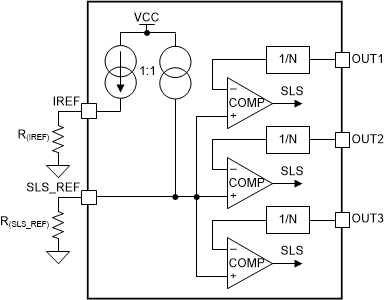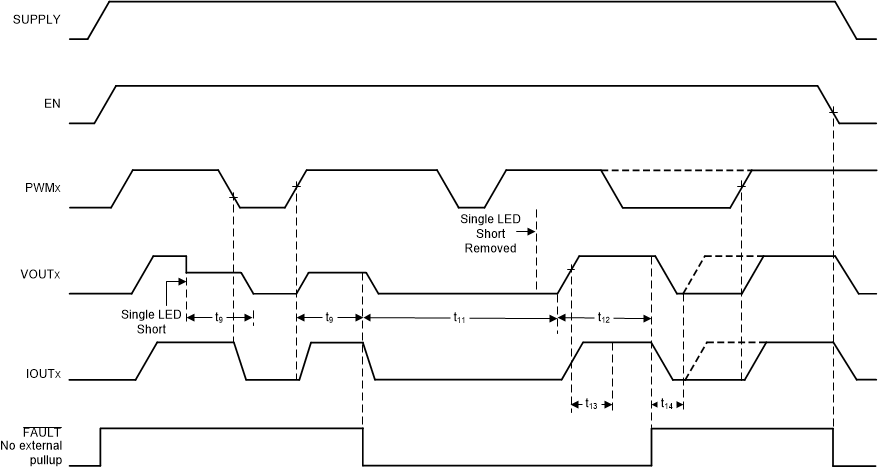SLVSFE8 June 2021 TPS92633
PRODUCTION DATA
- 1 Features
- 2 Applications
- 3 Description
- 4 Revision History
- 5 Pin Configuration and Functions
- 6 Specifications
-
7 Detailed Description
- 7.1 Overview
- 7.2 Functional Block Diagram
- 7.3
Feature Description
- 7.3.1 Power Supply (SUPPLY)
- 7.3.2 Enable and Shutdown (EN)
- 7.3.3 Reference Current (IREF)
- 7.3.4 Constant-Current Output and Setting (INx)
- 7.3.5 Analog Current Control (ICTRL)
- 7.3.6 Thermal Sharing Resistor (OUTx and RESx)
- 7.3.7 PWM Control (PWMx)
- 7.3.8 Supply Control
- 7.3.9
Diagnostics
- 7.3.9.1 IREF Short-to-GND Detection
- 7.3.9.2 IREF Open Detection
- 7.3.9.3 LED Short-to-GND Detection
- 7.3.9.4 LED Open-Circuit Detection
- 7.3.9.5 Single LED Short-Circuit Detection (SLS_REF)
- 7.3.9.6 LED Open-Circuit and Single LED Short-Circuit Detection Enable (DIAGEN)
- 7.3.9.7 Low Dropout Operation
- 7.3.9.8 Over-Temperature Protection
- 7.3.10 FAULT Bus Output With One-Fails–All-Fail
- 7.3.11 FAULT Table
- 7.3.12 LED Fault Summary
- 7.3.13 IO Pins Inner Connection
- 7.4 Device Functional Modes
- 8 Application and Implementation
- 9 Power Supply Recommendations
- 10Layout
- 11Device and Documentation Support
- 12Mechanical, Packaging, and Orderable Information
Package Options
Mechanical Data (Package|Pins)
- PWP|20
Thermal pad, mechanical data (Package|Pins)
- PWP|20
Orderable Information
7.3.9.5 Single LED Short-Circuit Detection (SLS_REF)
The TPS92633 device has single LED short-circuit detection. The single LED short-circuit detection monitors the output voltage when the output current is enabled. Once a single LED short-circuit failure is detected, the device turns off the faulty channel and retries automatically, regardless of the state of the PWM input. If the retry mechanism detects the removal of the single LED short-circuit fault, the device resumes to normal operation.
The TPS92633 monitors the V(OUTx) voltage of each channel and internally compares the scale down voltage of V(OUTx) with an external resistor programmable reference voltage on SLS_REF to detect a single LED short-circuit failure. When the voltage of V(OUTx) falls below V(SLS_th_falling) longer than the deglitch time of t(SLS_deg), the device asserts the single LED short-circuit fault and pulls low the FAULT pin. During the deglitch time period, if the scale down voltage of V(OUTx) rises above V(SLS_th_rising), the timer is reset.
Once the TPS92633 has asserted a single LED short-circuit fault, the device turns off the faulty output channel and retries automatically. During retrying the device sources full current from IN to OUT to pull up the LED loads every 10 ms for 300-µs period when the PWM input is logic high for the faulty channel. Once auto-retry detects the voltage of V(OUTx) rising above V(SLS_th_rising), it clears the single LED short-circuit fault and resumes to normal operation. The V(SLS_th_rising) is 2.5% higher the V(SLS_th_falling). The scale down ratio for V(OUTx) is N(OUT). Figure 7-9 describes internal diagram for single LED short-circuit detection circuit. And the V(SLS_th_falling) threshold voltage for single LED short-circuit is calculated by using Equation 6.
 Figure 7-9 Single LED Short-Circuit Detection Block Diagram
Figure 7-9 Single LED Short-Circuit Detection Block Diagram
where
- V(IREF) = 1.235 V (typical)
- R(IREF) = 12.3 kΩ recommended
- R(SLS_REF) is in kΩ unit
- N(OUT) = 4 (typical)
- N(SLS_REF) = 1 (typical)
The calculated result for V(SLS_th_falling) is 5.34 V when R(IREF) is 12.3 kΩ and R(SLS_REF) is 13.3 kΩ.
Figure 7-10 illustrates the timing for single-LED short-circuit detection, protection, retry and recovery.
 Figure 7-10 Single LED Short-Circuit Detection and
Recovery Timing Diagram
Figure 7-10 Single LED Short-Circuit Detection and
Recovery Timing DiagramThe detailed information and value of each time period in Figure 7-10 is described in Timing Requirements.